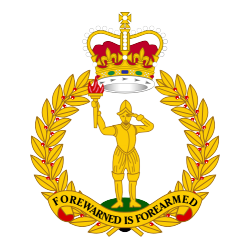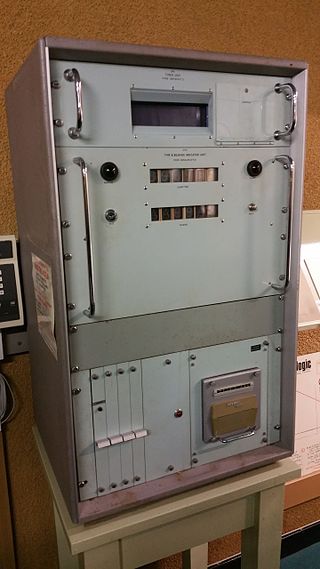
Civil defense or civil protection is an effort to protect the citizens of a state from human-made and natural disasters. It uses the principles of emergency operations: prevention, mitigation, preparation, response, or emergency evacuation and recovery. Programs of this sort were initially discussed at least as early as the 1920s and were implemented in some countries during the 1930s as the threat of war and aerial bombardment grew. Civil-defense structures became widespread after authorities recognised the threats posed by nuclear weapons.

RAF Bentley Priory was a non-flying Royal Air Force station near Stanmore in the London Borough of Harrow. It was the headquarters of Fighter Command in the Battle of Britain and throughout the Second World War. The Royal Air Force station closed its operations on 30 May 2008, with all units relocating to new accommodation at RAF Northolt, a few miles away.

The Diefenbunker, formerly known by its military designation, Canadian Forces Station Carp (CFS Carp), is a large underground four-storey reinforced concrete bunker and nuclear fallout shelter located in the rural area of Carp, Ontario approximately 30 km (19 mi) west of downtown Ottawa. Between 1957 and 1961, during the Cold War the Government of Canada led by then Prime Minister John Diefenbaker authorized the Diefenbunker to be designed and built as the Central Emergency Government Headquarters (CEGHQ Carp) in an attempt to ensure the continuity of government subsequent to a nuclear weapons attack by the Soviet Union. In 1994, CFS Carp was decommissioned and closed.
RAF Carlisle was a Royal Air Force establishment, now closed after being used for a variety of roles over a period of fifty eight years and formerly located 2 mi (3.2 km) north of Carlisle city centre in Cumbria, England.

Thiepval Barracks is a British Army barracks and headquarters in Lisburn, County Antrim.

The Royal Observer Corps (ROC) was a civil defence organisation intended for the visual detection, identification, tracking and reporting of aircraft over Great Britain. It operated in the United Kingdom between 29 October 1925 and 31 December 1995, when the Corps' civilian volunteers were stood down. Composed mainly of civilian spare-time volunteers, ROC personnel wore a Royal Air Force (RAF) style uniform and latterly came under the administrative control of RAF Strike Command and the operational control of the Home Office. Civilian volunteers were trained and administered by a small cadre of professional full-time officers under the command of the Commandant Royal Observer Corps; latterly a serving RAF Air Commodore.

The United Kingdom Warning and Monitoring Organisation (UKWMO) was a British civilian organisation operating to provide UK military and civilian authorities with data on nuclear explosions and forecasts of fallout across the country in the event of nuclear war.

Borras is a hamlet in Wrexham County Borough, Wales to the north-east of the city of Wrexham. It is part of the community of Holt.
Regional seats of government or RSGs were the best known aspect of Britain's civil defence preparations against nuclear war. In fact, however, naming conventions changed over the years as strategies in Whitehall changed.

Atomic Weapons Detection Recognition and Estimation of Yield known by the acronym AWDREY was a desk-mounted automatic detection instrument, located at 12 of the 25 Royal Observer Corps (ROC) controls, across the United Kingdom, during the Cold War. The instruments would have detected any nuclear explosions and indicated the estimated size in megatons.

The Ground Zero Indicator, known by the acronym GZI was a specially designed shadowgraph instrument used by the British Royal Observer Corps during the Cold War to locate the Ground Zero of any nuclear explosion. It consisted of four horizontally mounted cardinal compass point pinhole cameras within a metal drum. Flash from a nuclear explosion would produce a mark on one or multiple of the papers within the drum and its position of the mark has enabled the bearing and height of the burst to be estimated in terms of engineering. With a triangulation between both neighbouring posts these type of readings would give an considered accurate height and position, which is identified by assessing the height of the explosion imprint above the horizon level that had been pre-exposed onto the paper.

Royal Air Force Wrexham, or more simply RAF Wrexham, is a former Royal Air Force station at Borras, on the outskirts of Wrexham, Wales and north-east of the city centre.

Royal Observer Corps monitoring posts are underground structures all over the United Kingdom, constructed as a result of the Royal Observer Corps' nuclear reporting role and operated by volunteers during the Cold War between 1955 and 1991.

Holgate is a suburb of York in England. It is located about 1 mile west of Micklegate Bar in the city walls. Holgate is also the name of an electoral ward in the City of York unitary authority. The ward is currently bounded by the River Ouse from Scarborough Bridge to Ouse Acres on its northern boundary. Carr Lane and Ouse Acres on one side, and the intersection of York Road and Acomb Road on the other, make up its western boundary. The remainder of the southern boundary follows Moorgate and Holgate Beck to the East Coast Main Line railway which completes the eastern boundary as far as the River Ouse/Scarborough Bridge.

Royal Air Force Shipton was a First World War era airfield located north of the village of Shipton-by-Beningbrough, in North Yorkshire, England. During the First World War, it was used by No. 76 Squadron RAF whose remit was to provide Home Defence (HD).


















